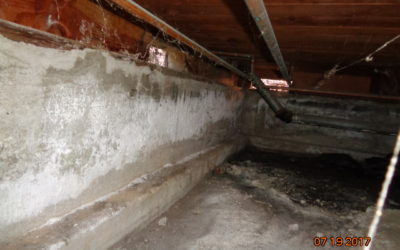PCA Inspections Blog | Local information and news related to home inspections
Read the PCA Inspections blog to learn more about our services and news related to the home inspections industryChimney Counter-Flashing Shows Quality
A common question I get from buyers is to grade the quality of the work in a house, particularly with flips. One item to look at when you have a brick chimney is to see what type of counter-flashing is on the chimney. First, what is counter-flashing? ...
Is Your Garage a Fire Hazard?
Not many people think of garages as a fire hazard, but with the potential of a car fire and the storage of hazardous materials (ex: gasoline and fertilizers) it can be a recipe for a disaster. For this reason, current building standards require at least a...
Why is there Gravel on My Roof?
You may be wondering why some buildings have gravel on the roof. Simple, it protects the tar from the sun. UV rays can break down and dry out the tar membrane causing the tar to crack (some describe it as “alligatoring”). The light color rocks reflect...
Spotting an Electrical Panel that Needs to be Replaced
One item to consider during a home inspection is the electrical panel manufacturer. Specifically, you should be aware of the Federal Pacific Electric (FPE) panel . These panels were typically installed between the 1950s to the 1980s. They have a high...
4 Tips for Finding a Construction Contractor
How to properly vet a contractor? Finding and vetting a contractor for a home renovation can be difficult and expensive if you pick the wrong contractor. Most home owners usually have little experience with construction and can easily be bamboozled by a slick talking...
4 Common Water Heater Installation Defects
Water Heater Defects Found During Home Inspections If there is one item home inspectors love to spot problems with, it’s water heaters. Probably because they’re the easiest to spot. But for the average person, issues with water heaters might not be so...
Inspecting and Solving Exterior Drainage System Around Your Home
Every year, homeowners take precautionary measures to protect their properties from floods and rain water. However, if you fail to pay attention to your storm water drainage system; you may have to deal with expensive in-house plumbing or costly exterior...
Top 3 Ways to Prevent Subterranean Termites
What's the biggest fear you have when it comes to the well-being of your house? I guess this isn't The Wizard of Oz, so the idea of a cyclone is pretty far-fetched. However, one widespread fear among anyone is that of a termite infestation. Termites can be...
Top 10 things to do to Prepare a House for an Inspection
San Francisco is one of the few places in the country were seller inspections are more common than buyer inspections. However, very few prepare their house for an inspection. With a little bit of effort you can prevent those nagging comments from common...
What are those white chalky stains on my foundation?
If you’ve been in a lot of basements in San Francisco, you’ll have noticed some foundations have water stains with a chalky, white appearance. This is called “efflorescence”. This develops as the salt minerals in the concrete slough off as water drains...

Chimney Counter-Flashing Shows Quality
A common question I get from buyers is to grade the quality of the work in a house, particularly with flips. One item to look at when you have a brick chimney is to see what type of counter-flashing is on the chimney. First, what is counter-flashing? ...

Is Your Garage a Fire Hazard?
Not many people think of garages as a fire hazard, but with the potential of a car fire and the storage of hazardous materials (ex: gasoline and fertilizers) it can be a recipe for a disaster. For this reason, current building standards require at least a...

Why is there Gravel on My Roof?
You may be wondering why some buildings have gravel on the roof. Simple, it protects the tar from the sun. UV rays can break down and dry out the tar membrane causing the tar to crack (some describe it as “alligatoring”). The light color rocks reflect...

Spotting an Electrical Panel that Needs to be Replaced
One item to consider during a home inspection is the electrical panel manufacturer. Specifically, you should be aware of the Federal Pacific Electric (FPE) panel . These panels were typically installed between the 1950s to the 1980s. They have a high...

4 Tips for Finding a Construction Contractor
How to properly vet a contractor? Finding and vetting a contractor for a home renovation can be difficult and expensive if you pick the wrong contractor. Most home owners usually have little experience with construction and can easily be bamboozled by a slick talking...

4 Common Water Heater Installation Defects
Water Heater Defects Found During Home Inspections If there is one item home inspectors love to spot problems with, it’s water heaters. Probably because they’re the easiest to spot. But for the average person, issues with water heaters might not be so...

Inspecting and Solving Exterior Drainage System Around Your Home
Every year, homeowners take precautionary measures to protect their properties from floods and rain water. However, if you fail to pay attention to your storm water drainage system; you may have to deal with expensive in-house plumbing or costly exterior...

Top 3 Ways to Prevent Subterranean Termites
What's the biggest fear you have when it comes to the well-being of your house? I guess this isn't The Wizard of Oz, so the idea of a cyclone is pretty far-fetched. However, one widespread fear among anyone is that of a termite infestation. Termites can be...

Top 10 things to do to Prepare a House for an Inspection
San Francisco is one of the few places in the country were seller inspections are more common than buyer inspections. However, very few prepare their house for an inspection. With a little bit of effort you can prevent those nagging comments from common...

What are those white chalky stains on my foundation?
If you’ve been in a lot of basements in San Francisco, you’ll have noticed some foundations have water stains with a chalky, white appearance. This is called “efflorescence”. This develops as the salt minerals in the concrete slough off as water drains...









